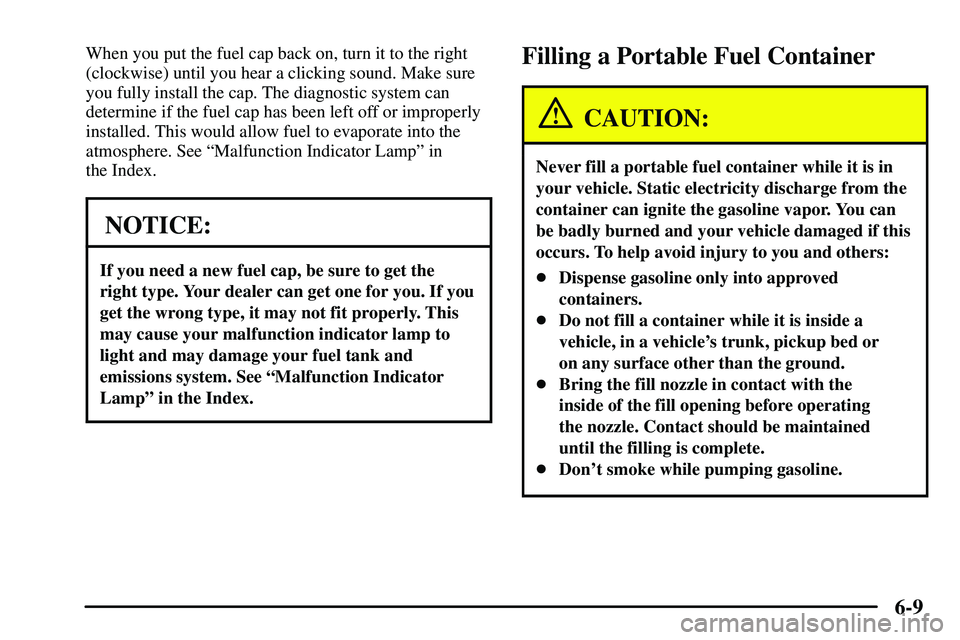Page 253 of 381
6-8
While refueling, hang the fuel cap inside the fuel door.
To remove the fuel cap, turn it slowly to the left
(counterclockwise).
CAUTION:
If you get fuel on yourself and then something
ignites it, you could be badly burned. Fuel can
spray out on you if you open the fuel cap too
quickly. This spray can happen if your tank is
nearly full, and is more likely in hot weather.
Open the fuel cap slowly and wait for any ªhissº
noise to stop. Then unscrew the cap all the way.
Be careful not to spill fuel. Clean fuel from painted
surfaces as soon as possible. See ªCleaning the Outside
of Your Vehicleº in the Index.
Page 254 of 381

6-9
When you put the fuel cap back on, turn it to the right
(clockwise) until you hear a clicking sound. Make sure
you fully install the cap. The diagnostic system can
determine if the fuel cap has been left off or improperly
installed. This would allow fuel to evaporate into the
atmosphere. See ªMalfunction Indicator Lampº in
the Index.
NOTICE:
If you need a new fuel cap, be sure to get the
right type. Your dealer can get one for you. If you
get the wrong type, it may not fit properly. This
may cause your malfunction indicator lamp to
light and may damage your fuel tank and
emissions system. See ªMalfunction Indicator
Lampº in the Index.
Filling a Portable Fuel Container
CAUTION:
Never fill a portable fuel container while it is in
your vehicle. Static electricity discharge from the
container can ignite the gasoline vapor. You can
be badly burned and your vehicle damaged if this
occurs. To help avoid injury to you and others:
�Dispense gasoline only into approved
containers.
�Do not fill a container while it is inside a
vehicle, in a vehicle's trunk, pickup bed or
on any surface other than the ground.
�Bring the fill nozzle in contact with the
inside of the fill opening before operating
the nozzle. Contact should be maintained
until the filling is complete.
�Don't smoke while pumping gasoline.
Page 257 of 381
6-12 Engine Compartment Overview
When you open the hood of the 1.8 L (Code 8) engine, you'll see the following:
A. Windshield Washer
Fluid Reservoir
B. Power Steering Fluid Reservoir
C. Radiator Pressure Cap
D. Engine Oil DipstickE. Coolant Recovery Tank
F. Engine Oil Fill Cap
G. Automatic Transaxle Fluid
Dipstick (If Equipped)H. Brake/Hydraulic Clutch
Fluid Reservoir
I. Engine Air Cleaner/Filter
J. Battery
K. Engine Compartment Fuse Block
Page 258 of 381
6-13
When you open the hood of the 1.8 L (Code L) H.O. DOHC engine, you'll see the following:
A. Windshield Washer Fluid
Reservoir
B. Power Steering Fluid Reservoir
C. Radiator Pressure Cap
D. Engine Oil DipstickE. Coolant Recovery Tank
F. Engine Oil Fill Cap
G. Automatic Transaxle Fluid
Dipstick (If Equipped)H. Brake/Hydraulic Clutch Fluid
Reservoir
I. Engine Air Cleaner/Filter
J. Battery
K. Engine Compartment Fuse Block
Page 271 of 381
6-26
Then, without shutting off the engine, follow
these steps:
The automatic transaxle
dipstick has an orange
handle and is located near
the front of the engine
compartment. See ªEngine
Compartment Overviewº in
the Index for more
information on location.
1. Release the tab and pull out the dipstick and wipe it
with a clean rag or paper towel.
2. Push it back in all the way, wait three seconds and
then pull it back out again.
3. Check both sides of the dipstick, and read the lower
level. The fluid level must be between the two
dimples in the hot range.
4. If the fluid level is in the acceptable range, push the
dipstick back in all the way; then press the tab down
to lock the dipstick in place.
Page 272 of 381
6-27 How to Add Fluid
Refer to the Maintenance Schedule to determine what
kind of transaxle fluid to use. See ªRecommended
Fluids and Lubricantsº in the Index.
If the fluid level is low, add only enough of the proper
fluid to bring the level into the area between dimples on
the dipstick.
1. Pull out the dipstick.
2. Using a long
-neck funnel, add enough fluid at the
dipstick hole to bring it to the proper level.
It doesn't take much fluid, generally less than
one pint (0.5 L). Don't overfill.
NOTICE:
We recommend you use only fluid labeled AC
Delco T
-IV, because fluid with that label is made
especially for your automatic transaxle. Damage
caused by fluid other than AC Delco T
-IV is not
covered by your new vehicle warranty.
3. After adding fluid, recheck the fluid level as
described under ªHow to Check.º
4. When the correct fluid level is obtained, push the
dipstick back in all the way; then press the tab down
to lock the dipstick in place.
Page 290 of 381
6-45 Front Turn Signal Lamps
To replace the front turn signal lamp bulbs, do the
following:
1. See ªHeadlampsº for location.
2. Locate the turn signal bulb.
3. Turn the bulb socket counterclockwise and pull it out
of the lamp housing.
4. Reverse the steps to install a new bulb.
Rear Combination Lamps
To replace the turn signal and brake lamp bulbs, do the
following:
A. Brake Lamp
B. Turn Signal Lamp
Page 291 of 381
6-46
1. Access the bulbs through the storage compartment in
the rear cargo area of the vehicle. Remove the
storage compartment cover.
2. Turn the bulb socket
counterclockwise and
pull it out of the lamp
housing.
3. Pull the bulb straight out
of the socket.
4. Reverse the previous steps to install a new bulb.
5. Reinstall the cover.